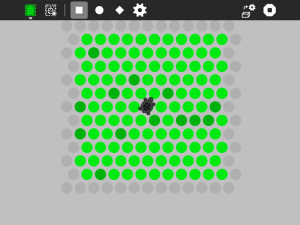Activities/Turtle in a Pond
Turtle in a Pond Activity
Turtle in a Pond is a strategy game. The goal is to surround the turtle before it runs of the screen.
How to play Turtle in a Pond
Did you know that:
- You can load your own strategy for the turtle
The Toolbars
- from left to right
- the Activity toolbar button (shown in the open position)
- the New-game button
- an area for messages
- the Load-new-strategy button
- the Reload-the-default-strategy button
- the Activity stop button
Strategy
In this strategy, the turtle moves down, regardless of whether the dot is open.
def _turtle_strategy(self, turtle):
turtle[1] +=1
return turtle
In this strategy, the turtle moves down until it is blocked.
def _turtle_strategy(self, turtle):
if not self._dots[self._grid_to_dot((turtle[0], turtle[1]+1))].type:
turtle[1] +=1
return turtle
In this strategy, the turtle searches for an open dot, looking clockwise.
def _turtle_strategy(self, turtle):
c = turtle[1] % 2
for i in range(6):
col = turtle[0] + CIRCLE[c][i][0]
row = turtle[1] + CIRCLE[c][i][1]
if not self._dots[self._grid_to_dot((col, row))].type:
return [col, row]
return turtle
In the default strategy, the turtle choose a random direction and goes there if the dot is open.
def _turtle_strategy(self, turtle):
c = turtle[1] % 2
n = int(uniform(0, 6))
for i in range(6):
col = turtle[0] + CIRCLE[c][(i + n) % 6][0]
row = turtle[1] + CIRCLE[c][(i + n) % 6][1]
if not self._dots[self._grid_to_dot((col, row))].type:
return [col, row]
return turtle
In this strategy, the turtle will go off the edge if it can.
def _turtle_strategy(self, turtle):
c = turtle[1] % 2
for i in range(6):
col = turtle[0] + CIRCLE[c][i][0]
row = turtle[1] + CIRCLE[c][i][1]
if self._dots[self._grid_to_dot((col, row))].type is None:
return [col, row]
n = int(uniform(0, 6))
for i in range(6):
col = turtle[0] + CIRCLE[c][(i + n) % 6][0]
row = turtle[1] + CIRCLE[c][(i + n) % 6][1]
if not self._dots[self._grid_to_dot((col, row))].type:
return [col, row]
return turtle
The dots are stored in a 13x13 array. Each dot has an attribute, 'type', that determines it status. The edges have a type=None. Occupied dots have a type=True. Unoccupied dots have a type=False.
Your strategy should start with:
def _turtle_strategy(self, turtle):
The turtle argument is a tuple containing the column and row of the current turtle position. That is, turtle[0] is the horizontal position and turtle[1] is the vertical position.
Your strategy should return a tuple containing the column and row of the new turtle position, e.g.,
return [col, row]
There are some resources that you can use in your program, including:
- CIRCLE
- a 2x6x2 array of offsets that can used to find the col and row of the dots surrounding the turtle.
- self._dots
- the array of dots.
- self._pressed
- the index of the most recent dot pressed by the user
- self._orientation
- you can set the orientation of your turtle by assigning a number from 0-5 (clockwise beginning with 30 degrees from north)
- self._set_label('your message here')
- you can write a message on the toolbar if you want to communicate what your turtle is thinking
Where to get Turtle in a Pond
The Turtle in a Pond activity is available for download from the Sugar activity portal: Turtle in a Pond
The source code is available on the Sugar Labs Gitorious server.

